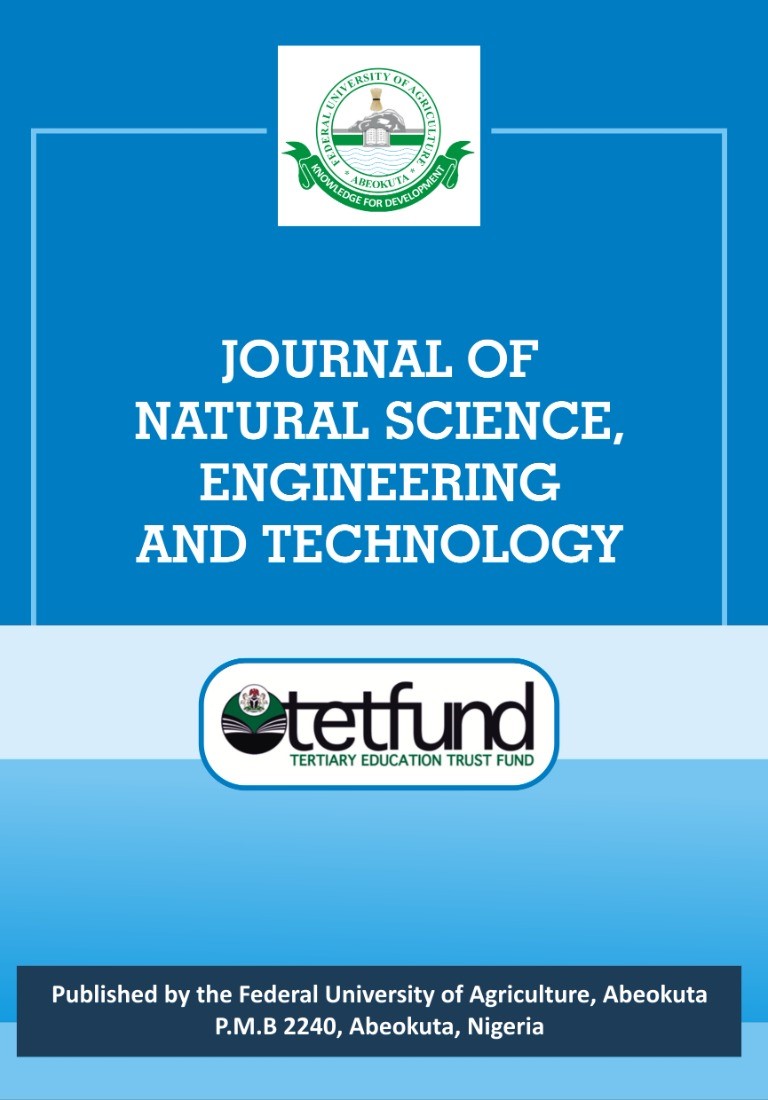LEAF EPIDERMAL STUDIES OF THREE APOCYNACEAE SPECIES (Allamanda cathartica Linn., Rauvolfia vomitoria Afzel. and Catharanthus roseus Linn.)
Keywords:
Apocynaceae, Epidermal, Stomata, Taxonomy and TrichomesAbstract
Apocynaceae is a family of flowering plants that comprises 200 genera and about 2000 species and is widely distributed in tropics and subtropics. In West Africa, it is made up of 37 genera and 138 species. This study focuses on enhancing the taxonomic classification of the Apocynaceae plant family in Nigeria by investigating leaf epidermal characteristics of three species. (Allamanda cathartica Linn., Rauvolfia vomitoria Afzel. and Catharanthus roseus Linn) at the Federal University of Agriculture, Abeokuta, Ogun State, Nigeria. Identification of species within this family is challenging due to the absence of easily distinguishable flowers and fruits. Leaf epidermal peels were obtained following standard procedures. Data obtained were subjected to descriptive analysis and one-way Analysis of variance. Common elliptic stomata shape was observed, except in A. cathartica, which exhibited additional circular stomata on the adaxial surface. C. roseus was identified as amphistomatic, distinguishing it from the hypostomatic nature of the other two species. Anisocytic stomata type was consistent across all species but A. cathartica and R. vomitoria displayed extra tetracytic stomata type, while C. roseus showcased distinct stomata types like diacytic, and paracytic. The studied species exhibited similarities in anticlinal wall patterns, non-glandular trichomes, and polygonal to irregular epidermal cell shapes. A. cathartica had additional and different epidermal cell shapes which ranged from cylindrical, rectangular and triangular. The study emphasizes the taxonomic significance of epidermal characters like leaf surface, stomata type, anticlinal wall patterns, presence of non-glandular trichomes, distribution of stomata on leaf surfaces in delineating boundaries among the Apocynaceae species studied.
References
Adegbite, A.E. 2008. Leaf anatomical studies in some species of the tribe Cichorieae (Asteraceae) in Nigeria. Comparative Newsletter, 46: 49-58.
Ayodele A.E. and Olowokudejo J.D. 2006. The family Polygonaceae in West Africa. Taxonomic significance of lead epidermal character. South African Journal of Botany, 3: 442- 459.
El-Fiki, M.A.; El-Taher, A.M.; EL-Gendy, A.G. and Lila, M.I. 2019. Morphological and anatomical studies on some taxa of family Apocynaceae. Al-Azhar Journal of Agricultural Research, 44, 136–147.
Endress M.E. and Bruyns P.V. 2000. "A revised classification of the Apocynaceaes.l."(PDF). The Botanical Review, 66:1-56.
Fabeku, P.O. 2006. Traditional Medicine: The Arts, Ways and Practice. In Outlines and Pictures of Medicinal Plants from Nigeria, 1st edition; Tolu Odugbemi (editor); University of Lagos press: Lagos, Nigeria, Pp. 117–125.
Fayose, O.H. and Freke, R.M. 2016. A study on the Floral and Epidermal characteristics of two species of Ixora. International Journal of Medicinal Plant Research, 5:299–306.
Haruna, H. and Ashir, H.I. 2017. Leaf Epidermal Structures and Stomata Ontogeny in some members of the Lamiaceae Family. Bayero Journal of Pure and Applied Sciences, 10: 670–675.
Ibrahim, J.A.; Ayodele, A.E.; Jegede, A.I. and Kunle, Y.F. 2006. Comparative Studies on Khaya A. Juss. (Meliaceae) in Nigeria. African Journal of Biotechnology, 5:1154–1160.
Ibrahim, J.A.; Ayodele, A.E.; Okhale, S.E.; Jegede, A.I. and Kunle, O.F. 2009. The taxonomic significance of Agelanthus dodoneifolius (DC.) Polh. & Wiens in relation to its hosts. Nigerian Journal of Botany, 22: 89–101.
Ibrahim, J.A. and Ayodele, A.E. 2013. Taxonomic Significance of Leaf Epidermal Characters of the Family Loranthaceae in Nigeria. World Applied Sciences Journal, 24:1172–1179.
Kannabiran, B. and Ramassamy, V. 1988. Foliar epidermis and taxonomy in Apocynaceae. Proceedings of the Indian Academy of Sciences, 98: 409–417.
Li P.T., Leeuwenberg A.J.M. and Middleton D.J. 1995. Apocynaceae. Flora of China, 16:143−888.
Mbagwu, F.N. and Nwachukwu, C.U. 2008. Comparative Leaf Epidermal Studies on S. macrocarpon and S. nigrum. Research Journal of Botany, 3: 45-48.
Metcalfe, C. R. 1960. Anatomy of Monocotyledons. I. Gramineae. Clarendon Press, Oxford.
Metcalfe, C. R. 1989. Current Development in Systematic Plant Anatomy. In: V. H. Clarendon Press, Oxford.
Ng, F.S.P. 2006. Tropical Horticulture and Gardening. Kuala Lumpur, Malaysia: Clearwater Publications.
Ogunkunle, A.T.J. 2013. The Value of Leaf Epidermal Characters in Diagnosing Some Nigerian Species of Ficus L. (Moraceae). Research Journal of Botany, 8: 1–14.
Olowokudejo, J.D. (1990). Taxonomic value of petiole anatomy of genus Biscutella L. (Cruciferae). Phytomorphology, 40(3-4): 407-422.
Olowokudejo, J.D. and Nyananyo, B.L. 1990. Epidermal morphology of the genus Khaya (Meliaceae) in West Africa. Feddes Repertorium, 101: 401–407.
Omino, E.A. 1996. Contribution to the Leaf Anatomy and Taxonomy of Apocynaceae in Africa: The Leaf Anatomy of Apocynaceae in East Africa: A Monograph of Pleiocarpinae (Series of Revisions of Apocynaceae XLI). Ph.D. Thesis, Landbouw University, Wageningen, The Netherlands.
Oyedapo, O.A., Agbedahunsi, J.M., Illoh, H.C. and Akinloye, A.J. 2018. Comparative foliar anatomy of three Khaya species (Meliaceae) used in Nigeria as ant sickling agent. Science of the Cold Arid Regions, 10:279–285.
Schmidt D.F.N., Yunes R.A., Schaab E.H., Malheiros A., Filho V.C. and Franchi G.C. 2006. Evaluation of the anti-proliferative effect of the extracts of Allamanda blanchetti and A. schottii on the growth of leukemic and endothelial cells. Journal of Pharmacy and Pharmaceutical Science, 9(2): 200-208.
Shokefun, E.O., Ayodele, A.E. and Orijemie, E.A. 2017. A preliminary leaf epidermal and pollen morphology of some West African species of Desplatsia Bocq. Journal of Medical Plant for Economic Development, 1(1), a4, DOI: https://doi.org/10.4102/jomped.v1i1.4.
Wiart, C. 2006. Medicinal Plants of Asia and the Pacific. Boca Raton: CRC Press/Taylor and Francis, Pages 336,https://doi.org/10.1201/9781420006803.
Wong S.K., Lim Y.Y., Abdullah N.R. and Nordin F.J. 2011. Antiproliferative and phytochemical analyses of leaf extracts of ten Apocynaceae species. Pharmacognosy Research, 3:100−106.

